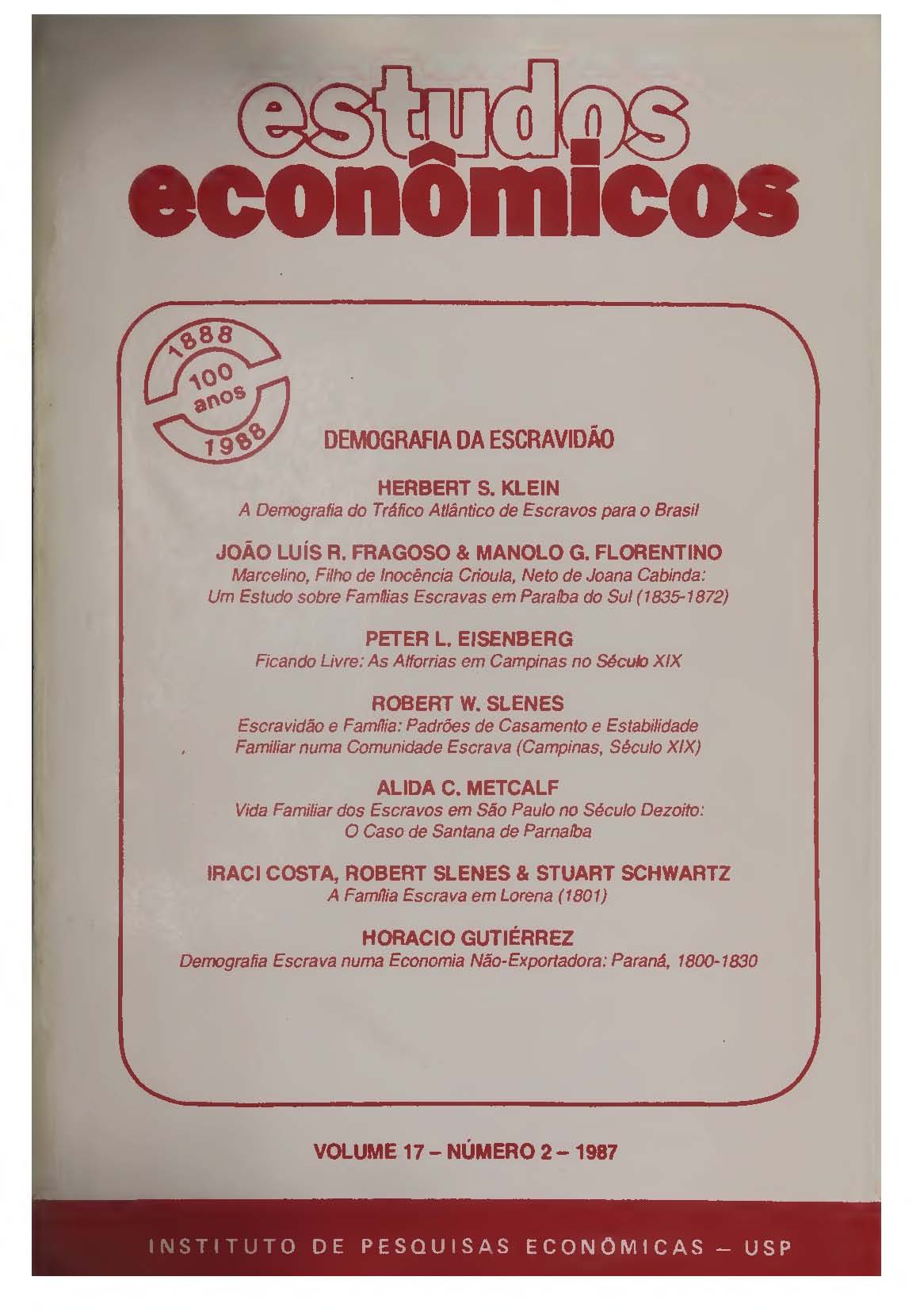Vida familiar dos escravos em São Paulo no século dezoito: o caso de Santana de Parnaíba
Abstract
In this paper, two models of slave survival strategies are studied. To Genovese, the slaves were parts of the patriarchal family of their Lords, depending on their will; to Gutman, the slave family was a fundamental Institution and the relationship among slaves were important for their survival. The slave's demographic analysis in Santana, de Parnaiba, between 1720/1820, indicates that the two models are not mutually exclusive. On the other hand, the slave family can also be seen, as pointed out by Higman, within the economic structure, since the instability of the slave family life was related to the farms economics changes
Downloads
References
BASTIDE, Roger. As Religiões Africanas no Brasil. São Paulo, Pioneira, 1971.
BLASSINGAME, John. The Slave Community: Plantation Life in the Antebellum South. New York, Oxford University Press,, 1979.
COSTA, Emília Viotti. Da Senzala à Colônia. São Paulo, Difel, 1966.
COSTA, Iraci del Nero da. Vila Rica: Nota sobre Casamentos de Escravos (1727-1826). África, 4:105-109. São Paulo, Centro de Estudos Africanos da USP, 1981.
FREYRE, Gilberto. Casa-Grande & Senzala. Rio de Janeiro, José Olympio, 1961.
GENOVESE, Eugene. RollJordan Roll. New York, Pantheon, 1974.
GRAHAM, Richard. Slave Families on a Rural Estate in Colonial Brazil. Journal of Social History 9: 382-402, 1976.
GUTMAN, Herbert The Black Family in Slavery and Freedom. New York, Pantheon, 1976.
HIGMAN, Barry. The Slave Family and Household in the British West Indies, ^800'^834. Journal of Interdisciplinary History 6: 261 -287,1975.
HIGMAN, Barry. Slave Population and Economy in Jamaica, 1807-1834. Cambridge, Cambridge University Press, 1976.
KULIKOFF, Allan. The Beginnings of the Afro-American Family in Maryland. In: The American Family in SocialHistorical Perspective. 2nd Ed. Edited by Michael Gordon. New York, St Martin's Press, 1978.
MATTOSO, Katia M. de Queirós. £tre Esclave au Brasil XVF-XIX* Siecles. Paris, Hachette, 1979.
METCALF, Alida C. Families of Planters, Peasants, and Slaves: Strategies for Sun/ival in Santana de Parnaíba, Brazil, 1720-1820. Ph.D. dissertation, The University of Texas at Austin, 1983.
MONTEIRO, John. SSo Paulo in the Seventeenth Century: Economy and Society. Ph.D. dissertation, The University of Chicago, 1985.
PETRONE, Maria Theresa Schorer. A Lavoura Canavieira em Sio Paulo: ExpansSo e Declfnio (1765-1851). São Paulo, Difusão Européia do Livro, 1968.
PETRONE, Pasquale. Os Aldeamentos Paulistas e sua Função na Valorização da Região Paulistana: Estudo de Geografia Histórica. Tese de Livre Docência, Universidade de São Paulo, 1964.
RABOTEAU, Albert J. Slave Religion: The "Invisible Institution" in the Antebellum South. New York, Oxford University Press, 1978.
REIS DE QUEIROZ, Suely Robles. Escravidão Negra em São Paulo: Um Estudo das Tensões Provocadas pelo Escravismo no Século XIX. Rio de Janeiro, José Olympio, 1977.
SLENES, Robert W. The Demography and Economics of Brazilian Slavery, 1850-1888. Ph.D dissertation, Stanford University, 1975.
STEIN, Stanley J. Grandeza e Decadência do Café no Vale do Pamaíba. São Paulo, Brasiliense, 1961.
WETHERELL, Charles. Slave Kinship: A Case Study of the South Carolina Good Hope Plantation, 1835-1856. Journal of Family History 6: 294-308, 1981.
WOOD, Peter. Black Majority: Negroes in Colonial South Carolina. New York, W.W. Norton, 1974.
Downloads
Published
Issue
Section
License
Copyright (c) 1987 Alida C. Metcalf

This work is licensed under a Creative Commons Attribution-NonCommercial 4.0 International License.
By submitting an article, the author authorizes its publication and attests that it has not been submitted to any other journal. The original article is considered final. Articles selected for publication are proofread for grammatical and orthographic errors. The journal does not pay rights for published articles. The Institute of Economic Research from the School of Economics, Business and Accounting of the University of São Paulo (Instituto de Pesquisas Econômicas da Faculdade de Economia, Administração e Contabilidade da Universidade de São Paulo) owns the journal's copyright.




